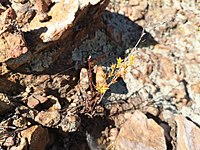Dudleya multicaulis
| Dudleya multicaulis | |
|---|---|

| |
| Scientific classification | |
| Kingdom: | Plantae |
| Clade: | Tracheophytes |
| Clade: | Angiosperms |
| Clade: | Eudicots |
| Order: | Saxifragales |
| Family: | Crassulaceae |
| Genus: | Dudleya |
| Species: | D. multicaulis
|
| Binomial name | |
| Dudleya multicaulis (Rose) Moran
| |
| Synonyms[2] | |
| |
Dudleya multicaulis is a succulent plant known by the common name manystem liveforever or many-stemmed dudleya. This Dudleya is endemic to southern California, where it is rare and becoming increasingly uncommon as its habitat is altered. This plant grows few short, fingerlike cylindrical leaves with pointed tips. It is dominated by its erect peduncle, which is topped with a branching inflorescence bearing up to 15 flowers on each long, thin branch. The flowers have pointed yellow petals and long stamens.
Description
Morphology
In this species, the caudex has been reduced to a subterranean structure roughly equivalent to a corm. The corm has an oblong shape, and measures 1.5–5 cm (0.59–1.97 in) long by 3–18 mm (0.12–0.71 in) wide. The leaves are arranged in 1 to 4 rosettes which are 2–6 cm (0.79–2.36 in) wide. The 5 to 15 green leaves are summer deciduous, with their surfaces not or somewhat glaucous. The leaves are shaped cylindric and linear except at the base, with the bases flushing with purple-red when the leaves are detached or damaged at that point. The leaves measure 4–15 cm (1.6–5.9 in) long by 2–6 mm (0.079–0.236 in) wide, with the base 4–10 mm (0.16–0.39 in) wide, and the tip of the leaf sharply acute.[3][4]
The inflorescence is on a peduncle 4–20 cm (1.6–7.9 in) high and 2–4 mm (0.079–0.157 in) wide. There are 7 to 18 strongly ascending bracts, with a similar linear shape to the rosette leaves. The inflorescence may first branch 2 or more times, and then subsequently rebranch 0 to 1 more times. The terminal branches (cincinni) are 2–10 cm (0.79–3.94 in) long, and have 3 to 15 flowers, which are suspended on pedicels 0.5–3 mm (0.020–0.118 in) long.[3][4]
The flowers are odorless. The petals are connate for 1–2 mm (0.039–0.079 in), and spread from the near middle, colored a bright yellow to a fading pale-yellow, and often lined-red at the keel. The petals are shaped elliptic-lanceolate and measure 5–9 mm (0.20–0.35 in) long by 2–3 mm (0.079–0.118 in) wide. The apex of the petals is acute. The sepals measure 2–3 mm (0.079–0.118 in) long and are shaped deltate-acute. The corolla measures 12–18 mm (0.47–0.71 in) in diameter. The pistils are connate for 1–2 mm (0.039–0.079 in) and are ascending. The ovaries are 3.5–6 mm (0.14–0.24 in) long, while the styles are 1.5–2 mm (0.059–0.079 in).[3][4]
Distribution
Most of its known occurrences are in Orange County, where it lives mostly along the coastal plain in heavy clay soils. It is threatened by development, road construction, and recreational activity.
Gallery
-
A cluster of plants
-
Detail of the developing buds
-
A plant with budding inflorescences
-
Flowers and buds
-
Flowering in habitat
References
- ^ "Dudleya multicaulis". NatureServe Explorer. Arlington, Virginia: NatureServe. 2022. Retrieved 21 April 2022.
- ^ "Dudleya multicaulis". Plants of the World Online. Royal Botanic Gardens, Kew. Retrieved 21 April 2022.
- ^ a b c McCabe, Stephen W. (2012). "Dudleya multicaulis". Jepson eFlora. Jepson Flora Project. Retrieved 21 April 2022.
- ^ a b c Moran, Reid. "Dudleya multicaulis". In Flora of North America Editorial Committee (ed.). Flora of North America North of Mexico (FNA). New York and Oxford: Oxford University Press. Retrieved 21 April 2022 – via eFloras.org, Missouri Botanical Garden, St. Louis, MO & Harvard University Herbaria, Cambridge, MA.






